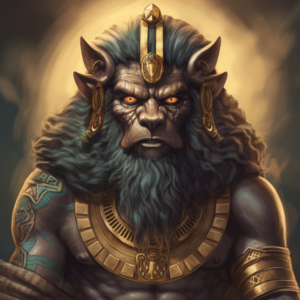Vesta is the Roman goddess of the hearth. The hearth is the stone floor surrounding a furnace or fireplace. This was important to the Romans, because sources of fire for cooking, lighting, and heating homes were not easy to acquire. Therefore, once a fire was started, it had to be fueled and maintained so that it could keep burning and other fires could be lit from it. This was done at both public hearths and in those of private homes. The hearth also represented family life, and therefore the community life of the Roman State.
Origins
Vesta is one of the original gods of Rome, born to her parents, Saturn and Ops. Saturn became concerned when an ancient prophecy was revealed and told about his children becoming his undoing. He worried about the prophecy and decided to eat his children as they were born, in order to keep his position as king of the Roman gods.
The first-born child of Saturn was Vesta. She was the first to be eaten by the Titan. Saturn would then eat four of her siblings. Eventually, a stone was given to Saturn by Ops in place of the last child, Jupiter, which made him vomit the five children out of his body.
Vesta was the oldest of the children of Saturn and Rhea, but she was the last to return from his stomach, making her both the youngest and the oldest of the children of the Titans.
Appearance
Vesta is a goddess living in a state of eternal innocence and virginity, based on the stories of her life. Vesta’s innocence is shown in artworks, with her always being fully-clothed and appearing in a homely setting. The myths associated with Vesta are based on her life, with Jupiter choosing to keep the peace between Apollo and Neptune over the destiny of the goddess.
Family
The most interesting part of the family life of Vesta was her birth story. The siblings of Vesta include Jupiter, Neptune, Pluto, Venus and Juno. There are no children associated with Vesta because she decided to ask Jupiter to allow her to remain untouched, and maintain her virginity forever. The myth of the virginity of Vesta explains that a war would have broken out between Neptune and Apollo for the hand of the goddess, had Jupiter not decided Vesta would remain pure forever.
Symbols
Vesta is often seen accompanied by a donkey. This was her animal of choice in her role as patroness to the bakers. Her fire was needed to bake the bread, as was the the donkey’s strength to turn the mill stone, making flour. The braying of the donkey was also said to ward off the lustful advances of other gods.
The symbol of Vesta is the kettle, which was used on the hearth of every Roman home to heat water. Vesta is depicted in a homely setting in most of the images of the goddess, with Vesta often linked directly with a flame lit beside her.
Powers & Duties
Vesta chose to take up the role of the protector of the home fires of Rome, which led to her followers becoming responsible for tending the fires of the Senate. The Vestal Virgins remained untouched and locked away from human view apart from one day per year. Vesta was responsible for the health of the people of Rome and protected the work of bakers reliant on the fire Vesta created.
Myths & Stories
Few myths of Vesta exist today. Roman poet Ovid relates a story in which the fertility god Priapus attempted to seduce Vesta. He was foiled by the loud braying of her donkey. It is thought that her worship was introduced by Numa Pompilius, second king of Rome, between 715 and 673 B.C.
Worship
Each sanctuary or temple of Vesta was usually a circular building that mirrored the round huts formerly used as dwellings in Italy. The shape was also symbolic of the hearth. One such Temple of Vesta was located in the Roman Forum, on the Pallatine Hill, built in the third century B.C. A fire was kept burning there continually by a group of six priestesses called the Vestal Virgins. These priestesses were selected for service by the pontifex maximus, or chief priest, between the ages of six and ten, and served in the temple for at least 30 years. During that time, they tended the fire, prepared ritual food offerings, drew water from a spring outside Rome, lived in the House of the Vestals near the temple, and had to maintain their virginity. If one of the Virgins broke her vow of chastity, the punishment was to be buried alive. After the 30 years had passed, they were free to marry. The Vestals enjoyed a high social status in Rome.
Each year on the Roman New Year, March 1, the perpetual fire in the temple was ritually extinguished and re-lit. If the fire went out at any other time, it was seen as a bad omen for Rome. The festival to Vesta, called the Vestalia, was held on June 7 to 15. Rituals included sweeping out the temple and ritually disposing of the sweepings. The festival was considered a time of bad luck until the sweeping was completed. Normally, the inner sanctuary of the temple, called the penus Vestae, was not open to the public, but on the first day of the festival, women bearing gifts could visit if they entered barefoot. The sacred fire of Vesta was maintained until 394 A.D., when most Roman religious cults were banned.
Because of the need for fire in everyday life, Vesta was worshiped in nearly every Roman home as well. Many homes had a household shrine that included an image of Vesta. She was often worshiped alongside household deities called Penates.
Art
Statues and other artwork depicting Vesta typically show her draped in long, full robes, wearing a stern expression and with her head covered. She often holds a scepter in one hand. Interestingly, a statue of the goddess was not included at any of her temples. However, the penus Vestae housed the Palladium, a statue of the Trojan Athena. This object was considered too sacred for a man too look upon. When it was rescued from a fire that destroyed the temple in 241 B.C., the rescuer – Roman Consul L. Caecilius Metellus, was then blinded for having seen the sacred statue. However, he was also afforded great honor for the daring rescue.
Today
As with many ancient deities, Vesta’s legacy continues in the naming of interstellar objects. In 1807, the asteroid now called Vesta was discovered by Wilhelm Olbers. It is the brightest and second largest asteroid in our solar system’s asteroid belt.
Facts about Vesta
- Vesta is the Roman goddess of the hearth.
- Hestia is the Greek goddess who is equivalent to Vesta.
- Vesta is commonly associated with the donkey and fire.
- Vesta is the protector of home fires of Rome.
- She was the oldest of Saturn’s six children.
- In mythology, she and four of her siblings were eaten by her father, Saturn.
- A Roman festival called Vestalia was dedicated to her and held from June 7 to 15.
- The words “Vesta” and “vestibule” are likely derived from similar roots, as vestibule means “a dwelling or front area of a house”.
- Few ancient statues of the goddess exist.






